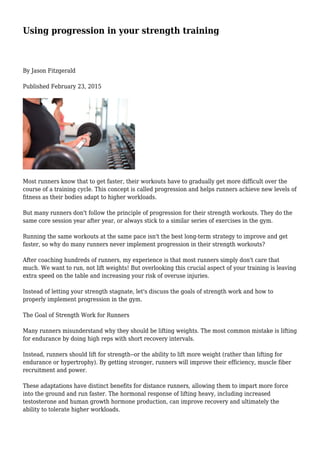
Using progression in your strength training
- 1. Using progression in your strength training By Jason Fitzgerald Published February 23, 2015 Most runners know that to get faster, their workouts have to gradually get more difficult over the course of a training cycle. This concept is called progression and helps runners achieve new levels of fitness as their bodies adapt to higher workloads. But many runners don't follow the principle of progression for their strength workouts. They do the same core session year after year, or always stick to a similar series of exercises in the gym. Running the same workouts at the same pace isn't the best long-term strategy to improve and get faster, so why do many runners never implement progression in their strength workouts? After coaching hundreds of runners, my experience is that most runners simply don't care that much. We want to run, not lift weights! But overlooking this crucial aspect of your training is leaving extra speed on the table and increasing your risk of overuse injuries. Instead of letting your strength stagnate, let's discuss the goals of strength work and how to properly implement progression in the gym. The Goal of Strength Work for Runners Many runners misunderstand why they should be lifting weights. The most common mistake is lifting for endurance by doing high reps with short recovery intervals. Instead, runners should lift for strength--or the ability to lift more weight (rather than lifting for endurance or hypertrophy). By getting stronger, runners will improve their efficiency, muscle fiber recruitment and power. These adaptations have distinct benefits for distance runners, allowing them to impart more force into the ground and run faster. The hormonal response of lifting heavy, including increased testosterone and human growth hormone production, can improve recovery and ultimately the ability to tolerate higher workloads.
- 2. Lift for strength by following these rules: Each exercise should be limited to 4-8 reps per set Lift so that the final set is challenging, but don't lift to failure Complete 2-3 sets for each exercise Take 2-3 minutes in between exercises to ensure ATP (the main energy source for the cells in your muscles) is replenished Use free weights (not machines) and focus on basic lifts that maximise muscle fibre recruitment like squats, dead lifts, bench press, cleans, lunges, and pull ups. Following these practices will ensure you're maximising strength gains from each workout. Start General, Then Get Specific If you're new to strength training, it's not a smart idea to jump into a series of heavy dead lifts on day one. Instead, follow the first rule of progression: start general. General strength forms the foundation that allows runners to progress to more advanced lifts in the gym. Start with relatively simple core exercises like planks, oblique twists and side planks. Exercises performed on the ground in a prone or supine position are more general than those performed standing up, since running is a standing activity. After 3-5 weeks of consistent core workouts, you're ready to progress to more advanced exercises. A valuable way to bridge the transition from bodyweight core exercises to difficult gym workouts is by starting with a medicine ball workout. Medicine balls are a helpful strength tool that can be used as the next logical step after bodyweight exercises become too easy. The same exercises you'll soon be doing in the gym--like squats, dead lifts, and lunges--can be done with a medicine ball. After another 3-5 weeks of combining general strength and medicine ball workouts, you can progress to more advanced lifts in the gym. Strength Training Tips to Remember Now that we know to start general with bodyweight exercises, move to medicine ball workouts and finally transition to weight lifting in the gym, we can fine-tune our approach to strength training with these 3 rules: Lifting is secondary to running. Strength work should enable and support your running, not detract from it. If running workouts are compromised by gym sessions, reduce the intensity so you can maintain the appropriate volume and intensity on workout days. Skip the bicep curls - and any other body-builder-centric exercises like tricep extensions or calf raises. Focus on movements, not muscles, by doing the exercises discussed earlier in this article. By
- 3. maximising muscle fibre recruitment, you'll get a bigger hormonal response that will aid recovery and strength gains. Lift on hard days. Too many runners schedule hard strength workouts on rest days or after an easy run. Instead, lift after your long run or faster workout to stimulate additional fitness adaptations. Lifting is as much about benefiting from neuromuscular adaptations as muscular adaptations. By lifting in a pre-fatigued state, the body learns to work hard when it's low on glycogen and still clearing byproducts from the running workout. Leg Strength Training This principle fits with the philosophy to make your "easy days easier and hard days harder." The best runners are often the strongest runners. By implementing a sound strength program within your training cycle, you'll realize all of its benefits: enhanced recovery, a faster finishing kick, increased strength, reduced risk of injury and improved running economy. Plus, you might enjoy how much better you look! About the Author: Jason Fitzgerald is the head coach at Strength Running, one of the web's largest coaching sites for runners. He is a 2:39 marathoner, USATF-certified coach and his passion is helping runners set monster personal bests. Follow him on Twitter @JasonFitz1 and Facebook. FILED UNDER: Training TAGS: Build / power / progression / strength / Training http://www2.gsu.edu/~wwwfit/strength.html http://www.emedicinehealth.com/strength_training/article_em.htm